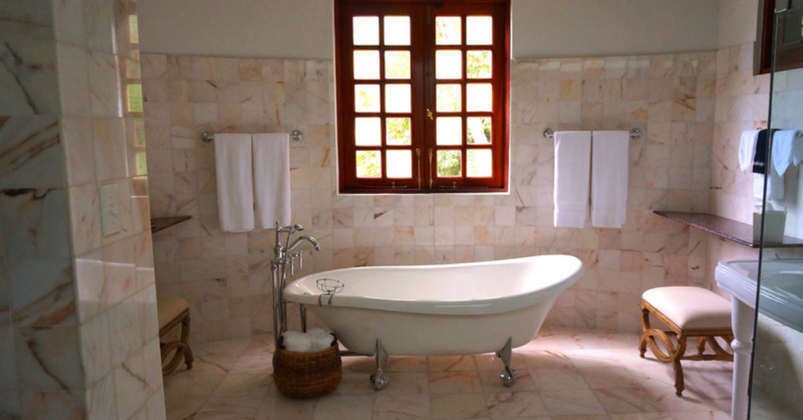8 Different Types of Bathtubs Explained
2021 Nov 10th
Find The Perfect Bath For Your Home
Bathtubs are not all equal. They can come in different shape, or different material. They are often used for different purposes whether it be for cleaner family members, cleaner pets, for laundry at times, or anything else. To get the best and most personalized use for your needs, here is a guide on the different type of bathtubs explained.
Alcove
The alcove tub is the classic tub that most of us grew up with. It is used against three walls, and is often also used as a shower. By being against the three walls, it helps maximize space in your bathroom. What is convenient about them is that they are inexpensive and come in different styles. However, since they usually do not extend 60 inches in length, they may not be best for a long luxurious soak. The Alcove is great for functionality.
Corner
The corner bathtub, just as the alcove bathtub, has a wall attachment. The corner bathtub usually attaches to only one or two walls rather than three. This bathtub is used mainly just for soaking in the tub, and not for showering. IT also gives the ability to create more space in your bathroom, and with a corner tub, can come a more creative design.
Clawfoot and freestanding
If you're looking for a vintage styled bathroom, the clawfoot is probably the way to go. They add character and give a nostalgic look to your space. This bathtub usually has a slanted back portion and made of cast iron or similar durable material. Its four decorative feet, gives an elegant touch, while also making it a main stand-out feature.
The freestanding tub is related to the clawfoot tub, as it can also be placed away from a wall, making it a great centerpiece for your bathroom. These usually have a pedestal for support and stability which also gives a luxury availability such as whirlpool or air effects. If you are looking for elegant, or modern design with comfort, this is a great choice.
Drop-In
Drop-in tubs are mounted into an existing surround. The surround can be different material such as marble tile, wooden cabinetry, or another surface. These tubs are relatively inexpensive and easy to install. Another pro about the drop-in tub is that they often have built-in storage shelves which is good for storing shampoos, soaps and other toiletries.
Undermount
In bathrooms with a lot of marble or other stone, you can’t go wrong with an undermount bathtub. These are installed by attaching them to the underside of the counter rather than the top. There is no lip to interrupt the beautiful lines of the tile or marble, making for an elegant, spa-like appeal that is inviting, yet practical.
Japanese
The ultimate in luxury, Japanese Soaking Tubs take the idea of a freestanding or deep clawfoot tub to a new height - literally. These deep, round tubs have a smaller footprint, making them great for smaller bathrooms, as they are designed for the bather to relax while sitting upright. They are not only fantastic for getting a good soak, their sleek lines elevate the style of the bathroom overall. Japanese tubs are often the showpiece of the room, situated in the middle of the space or in a place of distinction. Although traditionally, you are supposed to only soak in the tub, rather than wash yourself as with the western idea of an indoor tub, it is up to you how you actually use it.
Jetted
For sore muscles, aching back, or just to feel like you have a spa right at home, the jetted bathtub is the go-to. Jetted bathtubs are often found in may drop-in or corner bathtubs and the jets can be adjusted to your body. The hydrotherapy that they offer can be a big pro for people who suffer from body pains such as arthritis, and it can also give a luxurious feature to your bathroom routine.
Walk-In
Walk in tubs are great for people who may have mobility issues, especially with built-in chairs and grab bars for stability. Walk-in tubs combine the convenience of easy access with the therapeutic advantage of multiple jets for pain relief. They can be installed in the same amount of space as conventional tubs, though an alcove bathtub space would likely be too narrow.
What’s a Tub Made Of?
Now that you’ve seen the different types of bathtubs explained, let’s take a look at some of the different materials they might be made of. Here are a few common options:
- Cast iron: Most popular for clawfoot tubs or freestanding models, this material is extremely heavy but equally durable. It is coated in enamel for a smooth, comfortable feel.
- Fiberglass: A popular choice because of its low cost and moldability, fiberglass is prone to scratching over time. An acrylic coating can buy fiberglass bathtubs some extra time.
- Acrylic: This material can be molded into specific shapes, making it the go-to material for jetted tubs, which need a lot of contouring. It is also popular for walk-in bathtubs as it allows the seat and other considerations to be built in.
When buying a bathtub, there can be much to consider due to their different specifications: material, shape, style, and size are just a few. There are options for everyone, and you just have to decide what you are looking for, and what your price range is.

